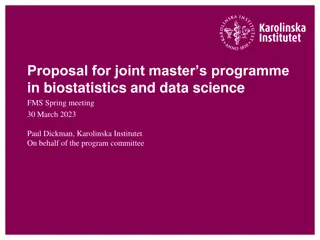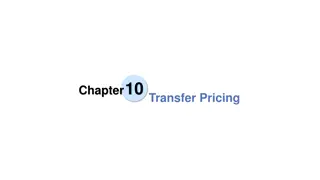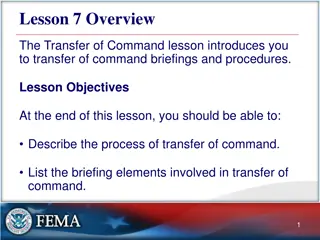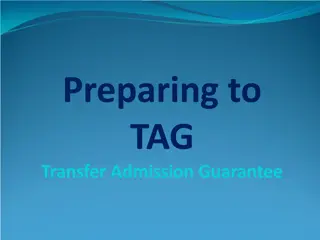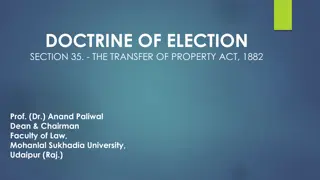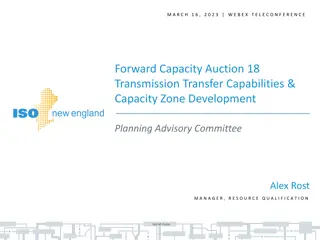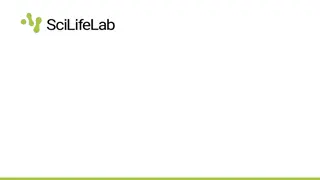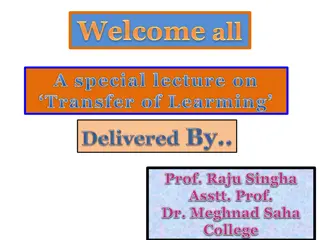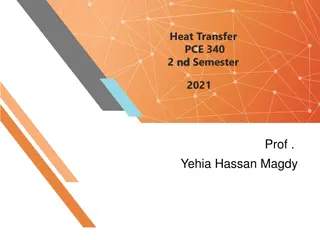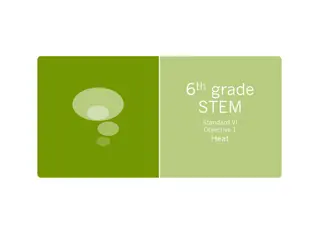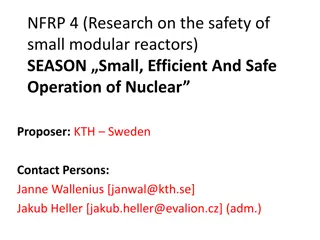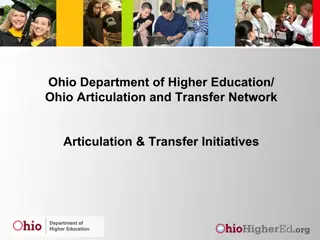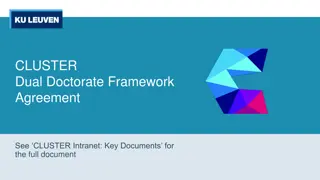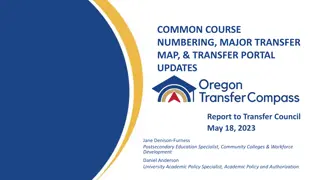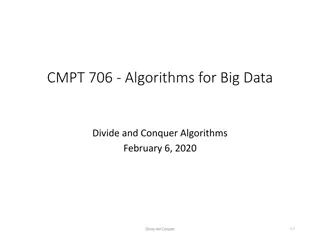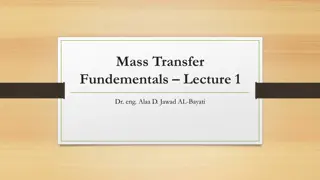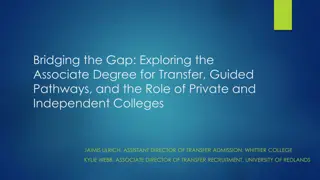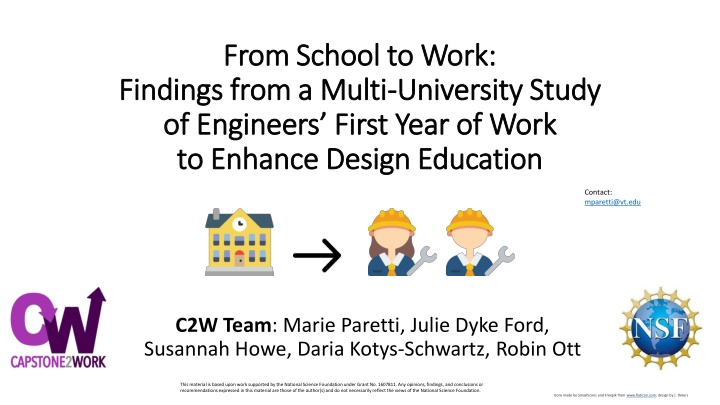
Key Insights from Engineering Education Study
Discover key findings from a comprehensive study on engineers' transition from school to work, aiming to enhance design education. The study delves into the first year of work experiences, emphasizing the importance of practical projects, workplace environment, guided mentorship, and industry collaboration in shaping engineers' development. Learn about the unique characteristics and challenges faced by engineering professionals as they navigate the academic-professional landscape.
Download Presentation

Please find below an Image/Link to download the presentation.
The content on the website is provided AS IS for your information and personal use only. It may not be sold, licensed, or shared on other websites without obtaining consent from the author. If you encounter any issues during the download, it is possible that the publisher has removed the file from their server.
You are allowed to download the files provided on this website for personal or commercial use, subject to the condition that they are used lawfully. All files are the property of their respective owners.
The content on the website is provided AS IS for your information and personal use only. It may not be sold, licensed, or shared on other websites without obtaining consent from the author.
E N D
Presentation Transcript
From School to Work: From School to Work: Findings from a Multi Findings from a Multi- -University Study of Engineers First Year of Work of Engineers First Year of Work to Enhance Design Education to Enhance Design Education University Study Contact: mparetti@vt.edu C2W Team: Marie Paretti, Julie Dyke Ford, Susannah Howe, Daria Kotys-Schwartz, Robin Ott This material is based upon work supported by the National Science Foundation under Grant No. 1607811. Any opinions, findings, and conclusions or recommendations expressed in this material are those of the author(s) and do not necessarily reflect the views of the National Science Foundation. Icons made by Smashicons and Freepik from www.flaticon.com; design by J. Deters
Some framing thoughts The objective [of engineering education] should be the development of intellectual power and judgment rather than the continuous or exhaustive coverage of a field of knowledge. In such rapidly expanding fields as science and technology, there is a natural tendency to increase the coverage of individual subjects until they become overcrowded with material of doubtful educational value. This tendency must be resisted firmly. The Lewis Report, cited in Edstr m (2018) The main challenge, then, is to find a productive relationship between academic and professional values, when making decisions regarding practical matters. Edstr m (2018) 2
C2W Study Overview Key Site Characteristic s Authentic projects 3-Month Interview (n=82*) ~400 students ~50 projects Weekly Journal ~150 students ~20 projects 6-Month Interview (n=81*) Workplace Environment ~30 students ~8 projects Anticipatory Interview Guided Mentorship 12-Month Interview (n=71*) Weekly Survey ~250 students ~30 projects Graduation n=132* Months 1-3 n=105* Four Sites Months 3-12 This material is based upon work supported by the National Science Foundation under Grant No. 1607811. Any opinions, findings, and conclusions or recommendations expressed in this material are those of the author(s) and do not necessarily reflect the views of the National Science Foundation. Slide design adapted from J. Deters; 3 Icons made by Becris, Freepik, and Smashicons from www.flaticon.com *Excludes participants who entered graduate school
Key Site Characteristics Key Site Characteristics Authentic Projects Workplace Environment Guided Mentorship Industry liaisons Industry partnership Project management Faculty scaffolding Complete design cycle (year-long projects) Professional communication Lifelong learning Frequent, regular stakeholder/client interaction Common documents Justifications for decisions Impacts beyond classroom Icons made by Freepik, photo3idea_studio, and Flat Icons from https://www.flaticon.com/ Project budgeting
Key Site Characteristics Key Site Characteristics Authentic Projects Workplace Environment Guided Mentorship Industry liaisons Industry partnership Project management Faculty scaffolding Complete design cycle (year-long projects) Professional communication Lifelong learning Frequent, regular stakeholder/client interaction Common documents Justifications for decisions Impacts beyond classroom Icons made by Freepik, photo3idea_studio, and Flat Icons from https://www.flaticon.com/ Project budgeting
Key Site Characteristics Key Site Characteristics Authentic Projects Workplace Environment Guided Mentorship Industry liaisons Industry partnership Project management Faculty scaffolding Complete design cycle (year-long projects) Professional communication Lifelong learning Frequent, regular stakeholder/client interaction Common documents Justifications for decisions Impacts beyond classroom Icons made by Freepik, photo3idea_studio, and Flat Icons from https://www.flaticon.com/ Project budgeting
Key Findings 92% 91% 85% 75% 74% Challenge Transfer from Capstone 66% 45% 34% Self-Directed Learning Teamwork & Communication Technical Work Identity Lack of knowledge Formal/informal presentations CAD Modeling Learning role Finding resources Software Feeling competent Formal/informal reports Finding work/keeping busy Calculations Belonging Design concepts Thinking like an engineer Interactions with colleagues Time management Mindset for grind Problem definition Prototyping/testing Interactions with supervisors Client meetings Tools & equipment Project budgeting Team meetings & processes
Key Findings 92% 91% 85% 75% 74% Challenge Transfer from Capstone 66% 45% 34% Self-Directed Learning Teamwork & Communication Technical Work Identity Lack of knowledge Formal/informal presentations CAD Modeling Learning role Finding resources Software Feeling competent Formal/informal reports Finding work/keeping busy Calculations Belonging Design concepts Thinking like an engineer Interactions with colleagues Time management Mindset for grind Problem definition Prototyping/testing Interactions with supervisors Client meetings Tools & equipment Project budgeting Team meetings & processes
Key Findings 92% 91% 85% 75% 74% Challenge Transfer from Capstone 66% 45% 34% Self-Directed Learning Teamwork & Communication Technical Work Identity Lack of knowledge Formal/informal presentations CAD Modeling Learning role Finding resources Software Feeling competent Formal/informal reports Finding work/keeping busy Calculations Belonging Design concepts Thinking like an engineer Interactions with colleagues Time management Mindset for grind Problem definition Prototyping/testing Interactions with supervisors Client meetings Tools & equipment Project budgeting Team meetings & processes
Key Findings 92% 91% 85% 75% 74% Challenge Transfer from Capstone 66% 45% 34% Self-Directed Learning Teamwork & Communication Technical Work Identity Lack of knowledge Formal/informal presentations CAD Modeling Learning role Finding resources Software Feeling competent Formal/informal reports Finding work/keeping busy Calculations Belonging Design concepts Thinking like an engineer Interactions with colleagues Time management Mindset for grind Problem definition Prototyping/testing Interactions with supervisors Client meetings Tools & equipment Project budgeting Team meetings & processes
Transfer in Self-Directed Learning Managing Knowledge Managing Time Lack of knowledge Finding resources People Documents Web Staying focused Handling pressure Balancing multiple tasks Paretti, M. C., Kotys-Schwartz, D., Ford, J. D., Howe, S., & Ott, R. (2020). Leveraging capstone design experiences to build self-directed learning. International Journal of Engineering Education, 36(2), 664-674. https://www.ijee.ie/latestissues/Vol36-2/14_ijee3903.pdf 14
Transfer in Self-Directed Learning Managing Knowledge Managing Time Lack of knowledge Finding resources People Documents Web Staying focused Handling pressure Balancing multiple tasks Paretti, M. C., Kotys-Schwartz, D., Ford, J. D., Howe, S., & Ott, R. (2020). Leveraging capstone design experiences to build self-directed learning. International Journal of Engineering Education, 36(2), 664-674. https://www.ijee.ie/latestissues/Vol36-2/14_ijee3903.pdf 15
Lack of Transfer in Self-Directed Learning Extended work on routine tasks The constraints of the work day 16
How do professional communication skills transfer? Ford, J. D., Paretti, M., Kotys-Schwartz, D., Howe, S., & Ott, R. New engineers transfer of communication activities from school to work (2021). IEEE Transactions on Professional Communication. 64(2): 105-120. 17
Transfer in Writing Skills - Genre Knowledge - Audience Awareness Ford, J. D., Paretti, M., Kotys-Schwartz, D., Howe, S., & Ott, R. New engineers transfer of communication activities from school to work (2021). IEEE Transactions on Professional Communication. 64(2): 105-120. 18
Lack of Transfer in Writing Skills - Genre Knowledge - Unfamiliar Genres - Information Sources - Audience Awareness - Networks of Relationships Ford, J. D., Paretti, M., Kotys-Schwartz, D., Howe, S., & Ott, R. New engineers transfer of communication activities from school to work (2021). IEEE Transactions on Professional Communication. 64(2): 105-120. 19
Challenges in Interpersonal Communication Building working relationships with diverse individuals Managing negative relationships Interacting with appropriate confidence Paretti, M., Ford, J. D., Kotys-Schwartz, D., Howe, S., & Ott, R. (2022) Preparing for Engineering Work: Interpersonal Relationships in the School to Work Transition. Proceedings of the IEEE/ASEE Frontiers in Education Conference. Uppsala. 20
Being Prepared For Work: Graduate Perspectives Correspondence Familiarity Strategies Direct transfer of skills (e.g. CAD, software, calculations) Similar situations at school and work Ways to approach new challenges Icons made by Freepik, photo3idea_studio, and Flat Icons from https://www.flaticon.com/
Being Prepared For Work: Graduate Perspectives Correspondence Familiarity Strategies Direct transfer of skills (e.g. CAD, software, calculations) Similar situations at school and work Ways to approach new challenges Icons made by Freepik, photo3idea_studio, and Flat Icons from https://www.flaticon.com/
Being Prepared For Work: Graduate Perspectives Correspondence Familiarity Strategies Direct transfer of skills (e.g. CAD, software, calculations) Similar situations at school and work Ways to approach new challenges Icons made by Freepik, photo3idea_studio, and Flat Icons from https://www.flaticon.com/
The Aims of Education Icons by Freepik, photo2idea_studio, from Flaticons.com 26
Learning in Communities of Practice Learning as belonging Community Learning as becoming Identity Learning Practice Learning as doing Meaning Learning as experience (Wenger, Communities of Practice, 1998) 27
Activities, tasks, functions, and understandings do not exist in isolation; they are part of broader systems of relations in which they have meaning. These systems of relations arise out of and are reproduced and developed within social communities, which are in part systems of relations among persons. The person is defined by as well as defines these relations. Learning thus implies becoming a different person with respect to the possibilities enabled by these systems of relations. To ignore this aspect of learning is to overlook the fact that learning involves the construction of identities. (Lave & Wenger, Situated Learning, 1991) Learning as belonging Community Learning as becoming Learning Practice Identity Learning as doing Meaning Learning as experience 28
Identity in practice is defined socially not merely because it is reified in a social discourse of the self and of social categories, but also because it is produced as a lived experience of participation in specific communities.(Wenger 1998) Learning as belonging Community Learning as becoming Learning Practice Identity Learning as doing Meaning Learning as experience 29
Identity as ongoing improvisation Structure Agency Historical Socially organized Socially maintained Distributed over landscapes of action Ability to decide Structures as externally constrained or internally persuasive Draws on identity resources Holland, D., Lachicotte, W. J., Skinner, D., & Cain, C. (1998). Identity and agency in cultural worlds. Harvard University Press. 30
Becoming After College: Agency and Structure in Transitions to Engineering Work Catherine Gewirtz, C. (2021). Twelve Tales of Engineering in the Real World: Narratives of Newcomers Agency in Transitions to Engineering Work. [Doctoral Dissertation, Virginia Tech]. Blacksburg, VA. https://vtechworks.lib.vt.edu/handle/10919/104897 31
Narrative Analysis Listening & Emotion Coding (audio/transcript review) Narrative coding (purpose, character, setting plot) Structure & Agency coding Construction of narratives and narrative summaries Analysis (thematic synthesis across narratives) 32
Emergent Themes Beyond Catherine Persistent sexism: Gender biases as consistently salient within organizational structures Objectification: Organizations objectifying employees Alienation: Distancing between engineering work and engineering impacts Dissonance: Disjunctions between participants descriptions of experiences and subsequent actions or interpretations 33


